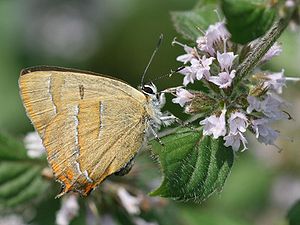Renal spot hairstreak
| Renal spot hairstreak | ||||||||||||
|---|---|---|---|---|---|---|---|---|---|---|---|---|

Renal spot hairstreak ( Thecla betulae ), male |
||||||||||||
| Systematics | ||||||||||||
|
||||||||||||
| Scientific name | ||||||||||||
| Thecla betulae | ||||||||||||
| ( Linnaeus , 1758) |
The Brown Hairstreak ( Thecla betulae ), and Birch Hairstreak called, is a butterfly ( butterfly ) from the family of Gossamer (Lycaenidae). The specific epithet is derived from Betula , the birch genus . However, these are not among the food plants of the caterpillars .
features
butterfly
The moths have a wingspan of 30 to 40 millimeters. Their wings are dark brown on top with orange spots in the anal corner , the females also have the large kidney-shaped spots on the forewing that give them their name. On the orange-brown underside of the wing there are white-framed, saber-tooth-shaped, dark orange-brown spots that point from the upper edge towards the lower edge. A submarginal bandage is only blurred and has no black points. The renal spot hairstreak can hardly be confused with other hairstyles, but the differences are clear ("saber tooth drawing") and allow photographic evidence.
Caterpillar
The caterpillars are light green with two light back and dashed diagonal stripes.
Flight time
Thecla betulae is univoltine , which means that it produces only one generation that flies from late July to October.
habitat
Sloe bushes, deciduous forest edges, even fruit trees are sometimes populated.
Way of life
Host plants are shrubs from the rose family, especially blackthorn ( Prunus spinosa ), plum ( Prunus domestica subsp. Domestica ) and other Prunus species. According to Bellmann, the specification of birch trees ( Betula ) as host plants is incorrect.
The conspicuous white eggs are laid individually or in pairs next to the buds of the host plants. The caterpillars hatch shortly before the leaves shoot and eat their way into the still closed bud. After that, they usually sit on the underside of the leaf and are difficult to spot there. When they reach their full size, they wander to the ground and transform into a brown pupa with dark flecks in the leaf litter.
According to Tolman and Lewington, the pupa is cared for by the black garden ant ( Lasius niger ). The moths stray and occasionally visit thistles, Ebert states that the butterfly food plant is unexplained.
distribution
Thecla betulae is spread across the Palearctic from Portugal and Ireland across temperate Europe to the Black Sea . Then along the southern deciduous and coniferous forest zone of Siberia to the Pacific . Missing in the Crimea and the Mediterranean islands. Widespread in Germany , but thinning in the north-west German lowlands and at high altitudes with the absence of food plants. Currently the species is not endangered. However, there are some declines due to land consolidation and intensification of agriculture through the application of fertilizers and pesticides .
swell
Individual evidence
- ^ Arnold Spuler: The butterflies of Europe . tape 1 . E. Schweitzerbartsche Verlagbuchhandlung, Stuttgart 1908, p. 54 .
- ^ W. Düring: kidney spot Zipfelfalter. In: Species portraits of butterflies in Rhineland-Palatinate. BUND RLP, August 16, 2020, accessed on August 16, 2020 .
- ↑ Tom Tolman, Richard Lewington: The butterflies of Europe and Northwest Africa . Franckh-Kosmos, Stuttgart 1998, ISBN 3-440-07573-7 .
- ↑ Butterfly. 2. Special part: Satyridae, Libytheidae, Lycaenidae, Hesperiidae . In: Günter Ebert, Erwin Rennwald (eds.): The butterflies of Baden-Württemberg . 1st edition. tape 2 . Ulmer, Stuttgart (Hohenheim) 1991, ISBN 3-8001-3459-4 .
- ↑ Rolf Reinhardt, Alexander Harpke, Steffen Caspari, Matthias Dolek, Elisabeth Kühn, Martin Musche, Robert Trusch, Martin Wiemers, Josef Settele: Distribution atlas of butterflies and rams in Germany . Ulmer, Stuttgart 2020, ISBN 978-3-8186-0557-5 , pp. 146 .
literature
- Hans-Josef Weidemann: Butterflies: observe, determine . Naturbuch-Verlag, Augsburg 1995, ISBN 3-89440-115-X .
- Heiko Bellmann : The new Kosmos butterfly guide, butterflies, caterpillars and forage plants . Franckh-Kosmos, Stuttgart 2003, ISBN 3-440-09330-1 .
- Manfred Koch : We determine butterflies. Volume 1: Butterfly. 4th enlarged edition. Neumann, Radebeul / Berlin 1966, DNB 457244224 .
- Elizabeth Balmer: Butterflies: Recognizing and Identifying. Parragon Books Ltd., Cologne 2007 ISBN 978-1407512037
Web links
- www.lepiforum.de: Photos and taxonomy
- www.schmetterling-raupe.de
- Moths and Butterflies of Europe and North Africa
- Thecla betulae at Fauna Europaea. Retrieved March 7, 2011

